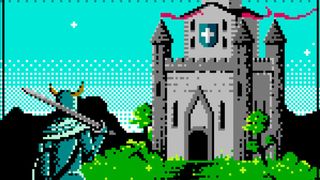Ukrainian indie Ringlorn Saga puts a fresh twist on the '80s PC game that pioneered action-RPGs
Bringing groundbreaking Japanese action-RPG Hydlide into the 21st century.

Pasokon Retro is our regular look back at the early years of Japanese PC gaming, encompassing everything from specialist '80s computers to the happy days of Windows XP.
The inspiration for retro-styled modern games can in theory come from almost anywhere, although in practice if a game's not citing a NES classic as its main influence then it'll probably be trying to recapture the essence of some Super Nintendo game, instead. There's a good reason for this tight focus on such a narrow area of gaming history: these styles are popular, practical, and amongst gamers of a certain age they come with a healthy dose of preorder-encouraging nostalgia baked in. It just makes good sense.
So it was something of a surprise to see Ringlorn Saga appear on Steam. It's an 8-bit styled adventure inspired by T&E Soft's ancient computer RPG Hydlide: a game that isn't popular, practical, or preorder-encouraging at all.
Hydlide debuted on the PC-88 in 1984, with a flurry of ports to just about every Japanese computer format available coming the year after. Like several games from that early and experimental era Hydlide was a true trailblazer, even though it had limited international impact at the time and has received little positive English-language attention in the years since. To give some idea of the state of the wider action-RPG market it was competing in back then: there wasn't one. Hydlide is regarded as one of the first games in the genre ever. This is pre-Ys ARPG-ing from a time when games were just as likely to be typed in by hand from a magazine listing as they were loaded from a cassette or (if you were lucky) floppy disk.
But what does any of that mean for Ringlorn Saga in 2022—being new yet deeply retro, based on a game few people have fond memories of, that has been outdone in every area in the decades since?
It actually means Ringlorn Saga feels surprisingly fresh amongst its modern peers. Even though it's drawing on design concepts created almost forty years ago, its small scope and simple rules naturally coalesce into a densely packed world filled with the sorts of tantalising mysteries more expansive RPG overworlds often lack.
Each tentative step in a new area or dark cave is just as likely to lead me to a curious new problem as it is an untimely death: mysterious statues dot the landscape, dark caverns must be lit by a lantern sourced from elsewhere, and the key to an imposing tower needs to be unearthed using tools I haven't found yet.
PC Gamer Newsletter
Sign up to get the best content of the week, and great gaming deals, as picked by the editors.
The landscape little prince Gerhard treks through is packed full of slimes, spiders, sorcerers, and all sorts of other monsters trying to halt my progress. Just like in Hydlide these monsters are attacked simply by running into them, and also just like in Hydlide I'm able to switch between attack-boosting and defence-enhancing fighting modes at will, the best mode for the fight at hand depending on my current circumstances, skill, and/or bravery.
Ringlorn Saga then expands upon this old framework with a simple trio of switchable attack types—slash, bash, stab—each one more effective against certain enemy types than others. To keep this new idea in line with the '80s-like experience that surrounds it I can only learn which attack will work best against an particular enemy type by either speaking to the game's tiny handful of friendly NPCs and listening to their advice, or using a bit of good old-fashioned experimentation and then remembering (or writing down) the results.




But as well-handled as these elements are, adding to someone else's old work can only take even the very best new games so far. Thankfully Ringlorn Saga seems to realise this and is definitely not like Hydlide in plenty of important ways too. It's generously sprinkled with changes and additions that suggest the developers spent some serious time analysing what didn't work in the original game just as much as what did.
Some of these alterations are simply a case of showing some basic consideration for the human playing the game. Ringlorn Saga mercifully doesn't open with its hero dumped in the middle of a field surrounded by enemies that can quickly kill him off, and it also offers more than a single screen's worth of explanatory text too. It's possible to manually save and quit at any time and in any place, and as dying only takes a small portion Gerhard's total XP rather than all his progress, there are no irritating "Wait, I didn't realise I hadn't saved for an hour" snags along the way even when I'm wiped out by a roaming Deathknight.
Inauthentically un-retro? Yes—and thank goodness for that.
But other changes channel forgotten ideas or even the technical limitations found in other '80s games, such as monster movement. Enemies can only move one tile at a time, and are locked to a simple grid. They also always turn to face their next direction of travel before they move. It's a subtle yet hyper-authentic detail that sparks new strategies in the moment: if I know where they're going to move next, then I also know when it's safe to sneak around the back of a monster I wouldn't survive a fight with—and that means I can (with a bit of luck) swipe precious treasures and key items from dangerous dungeons much earlier than I "should" be able to. It's a freedom that allows me to make my own story—to play a role—to a certain extent, to explore this little world on my own terms instead of having to accept a single, safe, and more strictly enforced pre-prepared route.




Role playing surfaces in another unexpected way too: the attack/defend battle system doubles up as a simple narrative tool. If I try to talk to a harmless villager while Gerhard's in attack mode they'll refuse to say much of anything, because from their point of view an armoured man is aggressively pointing his sword at them. It's the sort of small but significant feature that's been smoothed away over time in the name of convenience, even though it's logical and enriching in the moment.
And for once it really is worth being polite to NPCs, as almost everything they say is either a helpful clue to a larger puzzle or a piece of information that'll help me live longer. A stronger sword waiting in a place hinted at in a bard's song, the sad story of a graveyard ghost slowly pieced together over several conversations with multiple people, the location of someone who might have the item I'm looking for.
Hydlide deserves homages like Ringlorn Saga, someone bringing a dusty old legend back into the light even if only for a short while, but more importantly gaming deserves homages like Ringlorn Saga. Drawing upon a wider range of influences than the well-trod Castlevanias and Zeldas can lead to something new and surprising to play in the present, and gives retro gaming value beyond mere nostalgic reference spotting. By exploring games like Hydlide andRinglorn Saga, we gain fresh insight into a familiar era, one whose narrative isn't quite as set in stone or as well-mined as we perhaps think it is.
We just need brave developers aware enough of gaming's broader history to show us the way.

When baby Kerry was brought home from the hospital her hand was placed on the space bar of the family Atari 400, a small act of parental nerdery that has snowballed into a lifelong passion for gaming and the sort of freelance job her school careers advisor told her she couldn't do. She's now PC Gamer's word game expert, taking on the daily Wordle puzzle to give readers a hint each and every day. Her Wordle streak is truly mighty.
Somehow Kerry managed to get away with writing regular features on old Japanese PC games, telling today's PC gamers about some of the most fascinating and influential games of the '80s and '90s.

OG Fallout lead Tim Cain defends the show's lore changes in a glowing full review—'Not that it matters, I'm not in charge of this anymore, and neither are you'

The long-awaited sequel to The Ur-Quan Masters hits its crowdfunding target in less than four hours, and they're not kidding about that $4.4 million stretch goal
Most Popular





